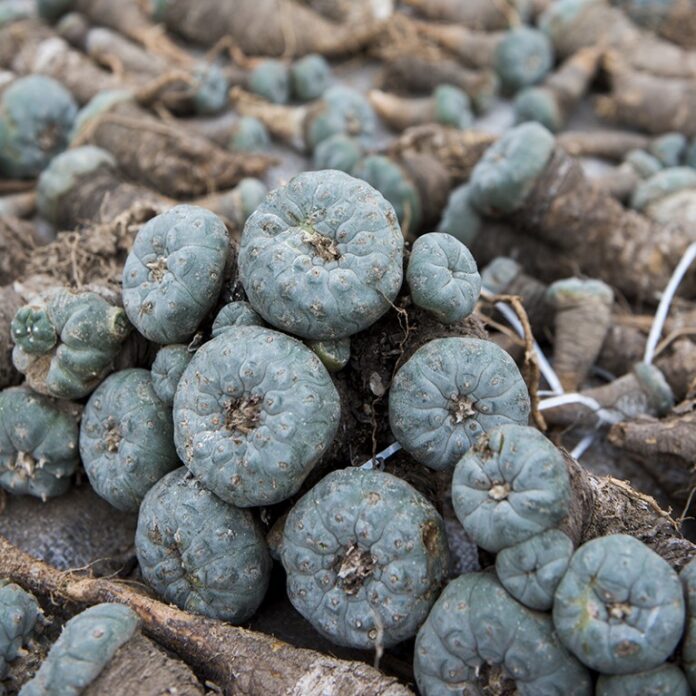Mescaline is a psychoactive alkaloid. It occurs naturally in several different species of psychedelic cacti found in North and South America, including San Pedro, peyote, and Peruvian Torch. Mescaline can also be synthesized in a laboratory setting.
Pure synthetic mescaline is usually a brownish or white crystalline powder, either loose or packed into capsules. It may also be found as a brew or liquid. Mescaline extraction is relatively rare in comparison with more common psychedelics.
What is the mescaline experience like?
The effects of mescaline generally start within 45-90 minutes after ingestion. The peak of the experience occurs at two to four hours, and the total experience lasts up to eight hours. Effects include strong closed-eye visuals and heightened senses. Many participants report that mescaline has a uniquely mystical quality (Barrett & Griffiths, n.d.).
The effects of synthetic mescaline may be slightly different from naturally-occurring mescaline, as found in San Pedro and other species, as psychedelic cacti also contain some other alkaloids (Dinis-Oliveira, Pereira, Dias da Silva, 2019). In general, anecdotal reports suggest that synthetic mescaline may provide a smoother experience, with less nausea, greater stimulant effects, and increased mental clarity.
A brief history of mescaline
In its natural form, mescaline has been an important aspect of Native American religious rituals and ceremonies for at least 5,000 years (Abbott, 2019). Mescaline in its cactus form is still used in the Native American Church (NAC).
Although it is not one of the most widespread psychedelics currently, mescaline was the first psychedelic substance to enter Western society and culture. Mescaline was used in mind-control experiments in Hitler’s Third Reich during World War II (Abbott, 2019). A few years later, The Doors of Perception, written by the English philosopher and writer Aldous Huxley, was published in 1954. It famously describes Huxley’s experience on mescaline and is one of the first mainstream accounts of a psychedelic journey. In recent years, mescaline has fallen out of popularity in comparison to other psychedelics, such as psilocybin, LSD, and ayahuasca.
Mescaline Safety
Although long-term research is limited, mescaline appears to be relatively safe. There are no known incidences of a lethal mescaline overdose, and a lethal dose has not yet been identified.
At very high doses, however, adverse effects can include hyperreflexia, tachycardia, agitation, muscle stiffness, ataxia, seizures, mydriasis, sialorrhea, hyperthermia and paresthesia (Dinis-Oliveira, Pereira, Dias de Silva, 2019). Some adverse effects appear to be limited to naturally-occurring mescaline. When pure synthetic mescaline was consumed in one study, vomiting and negative gastro-intestinal effects were not observed in any participants (Dinis-Oliveira, Pereira, Dias de Silva, 2019).
One study examined the use of mescaline-containing cacti in a ceremonial context among Native American populations and found no adverse effects (Halpern et al., 2005). In studies involving extremely high doses administered to lab rats, there was some evidence of impairment to problem-solving and memory, but the doses in the study far exceed any known human dose (Koupilová, Henrink & Krs, 1999).
Links have been established between mescaline and fetal abnormalities, so pregnant or breastfeeding women should avoid mescaline (Meyer, 2011).
Mescaline should not be consumed by individuals who have a heart condition or chronic hypertension. Mescaline should not be mixed with other medications or substances, especially medications for hypertension, alcohol, tramadol, immunomodulators, and stimulants (e.g. amphetamines or cocaine).
When ingesting mescaline, always follow basic psychedelic safety recommendations, including attention to set, setting, and sitter. Check out the PEx general safety guide.
Mescaline Science
Pharmacology
Mescaline has a phenethylamine structure. As a phenethylamine, it is similar to MDMA, but falls in a different class from tryptamines, such as LSD, DMT, and psilocybin.
Like most psychedelics, however, mescaline acts upon the brain’s serotonergic system, particularly serotonin 2A receptors. In addition to interacting with serotonin receptors, mescaline activates the brain’s dopaminergic system and binds with dopamine receptors.
Therapeutic Use
In comparison with other psychedelics, studies on the therapeutic potential of mescaline remain limited. There is some evidence, however, that mescaline increases activity and blood flow in the prefrontal cortex of the brain. Lower levels of activity in the prefrontal cortex are linked to anxiety and depression, suggesting that mescaline may be useful in treating certain mental disorders.
Mescaline’s interactions with both serotonin and dopamine receptors imply that it can help to boost mood and treat depression. In traditional Mesoamerican cultures, plant-based mescaline was used to treat depression. Its pharmacological similarity to MDMA also suggests a possible use in the treatment of PTSD.


